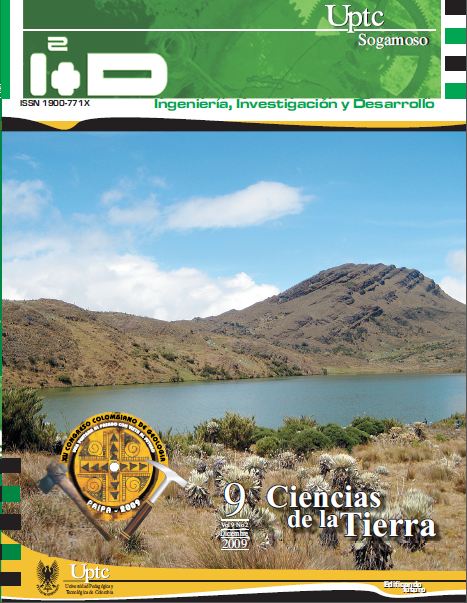Preliminary results of the first paleoseismologic study along the Bucaramanga fault, Colombia

Abstract
The Bucaramanga Fault is the fault in Colombia with the strongest physiographic expression. It extends from Aguachica in the north southward to Bucaramanga and beyond. Abundant morphotectonic indices testify to a high degree of activity during the Quaternary. A recent detailed regional study along the main fault corridor has identified several promising locations with potential for paleoseismologic trench studies. The site actually selected was situated in a limestone quarry at 4,5 km north of Bucaramanga town on the north bank of the Surata river. It concerns a small tectonic basin in a hanging valley situated 250 m to the west of the main Bucaramanga Fault and is filled with a series of colluvial wedges and fine grained lacustrine deposits with abundant organic material. Detailed logging of the outcrop face at a scale of 1:10 was carried out and seventeen samples were taken from the organic rich levels for radiocarbon dating. Basin evolution is controlled by movement of the principal fault trace in which each sedimentary level is a registration of co-seismic subsidence and represents the stratigraphic evidence of pre-historic earthquakes. The result of radiocarbon dating show ages that range from 8300-930 y/BP and a preliminary interpretation suggests the occurrence of 8 holocene seismic events during the last 8300 years and magnitudes in the order of 6,5-7,0 Ms.
Keywords
Bucaramanga fault, neotectonics, paleoseismology, sagpond, seismic stratigraphy, seismic hazard
References
- Audemard, F.A. (2003b): Geomorphic and geologic evidence of ongoing uplift and deformation in the Mérida Andes, Venezuela. Quat. International, 101- 102C, p. 43-65.
- Audemard, F.E.; Audemard, F.A., (2002): Structure of the Mérida Andes, Venezuela: relations with South America-Caribbean geodynamic interaction, Tectonophysiscs 345, p. 299-327.
- Boinet, T.; Bourgois, J.; Vargas, R.; Mendoza, H. (1989): La falla de Bucaramanga (Colombia), Su función durante la orogenia andina. Revista Norandina, Bogotá, v. 11, pp. 3-10.
- Cediel, F.; Shaw, R.P.; Cáceres, C. (2003): Tectonic assembly of the Northern Andean Block, AAPG Memoir, 79, p. 815-848.
- Freymüller, J.T.; Kellogg, J.N.; Vega, V., (1993): Plate motion in the North Andean region, JGR 98, pp. 21853- 21863.
- Ingeominas (2008): Mapa Geológico de Colombia, Escala 1:1.000.000.
- Julivert, M. (1959): Geología de la vertiente W del Macizo de Santander en el sector de Bucaramanga, Boletín de Geología, Universidad Industrial de Santander, No. 3, p.15-34.
- Laubscher, H.P. (1987). The kinematic puzzle of the neogene Northern Andes, In The history of mountain ranges. Schaer, J.P., Rodgers, J. (Eds.), Princeton Univ. Press, N.J.
- Pantosti, D.; Schwartz, D.P.; Valensise , G. (1993): Paleoseismology along the 1980 surface rupture of the Irpina fault; implications f o r e a r t h q u a k e recurrence in the southern Appennines, Italy. J.Geophys. Res, 98, pp. 15319-15341.
- Paris, G.; Machette, M.N.; Dart, R.L.; Haller, K.M. (2000): Map and Database of Quaternary Faults in Colombia and its Offshore Regions: U.S. Geological Survey Open-File Report 00-018, 61 p., 1 plate (1:2.000.000 scale).
- Taboada, A.; Rivera, L.A.; Fuensalida, A.; Cisternas, A.; Philip, H.; Bijwaard, H.; Olaya, J.; Rivera, C. (2000): Geodynamics of the Northern Andes: subduction and intracontinental deformation (Colombia), Tectonics 19 (5), pp. 787-813.
- Trenkamp, R.; Kellogg, J.N.; Freymüller, J.T.; Mora, H. (2002): Wide plate margin deformation, southern Central America and northwestern South America, CASA GPS observations. Jour. South Am. Earth Sci., 15, p. 157-171.
- Ujueta, G. (2003): La Falla de Santa Marta-Bucaramanga no es una sola falla; son dos fallas diferentes, la Falla de Santa Marta y la Falla de Bucaramanga. Geología Colombiana, No. 28, pp.133-153. I+D2 23.